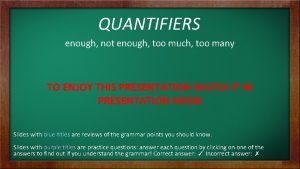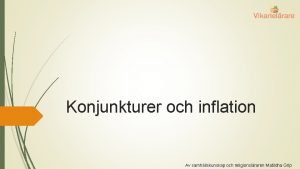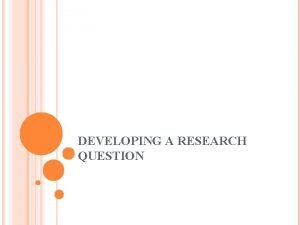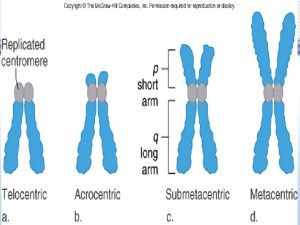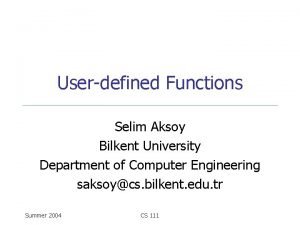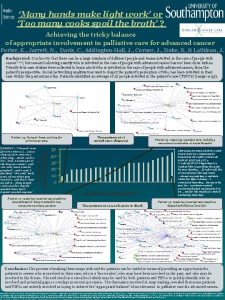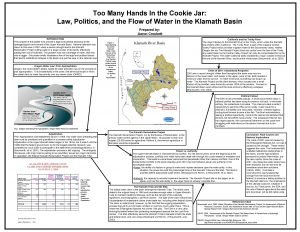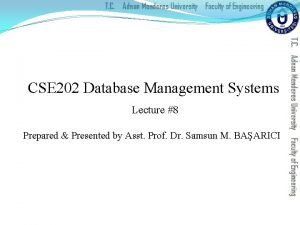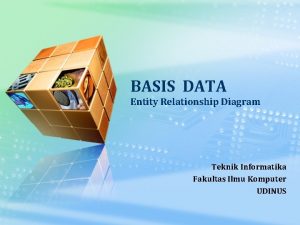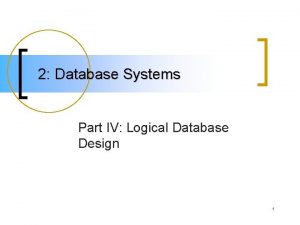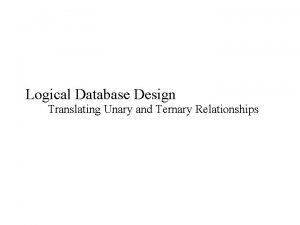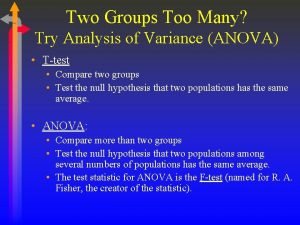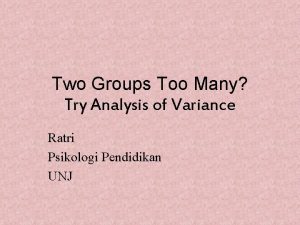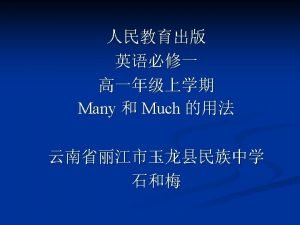Two is too many A personal review of












































- Slides: 44

Two is too many: A personal review of Two-Photon Physics Chung-Wen Kao Chung-Yuan Christian University, Taiwan 2007, 12. 24. National Taiwan Normal University

Nucleon structure n n Nucleons are the basic building blocks of atomic nuclei. Their internal structure, arising from the underlying quark and gluon constituents, determines their mass, spin, and interactions. These, in turn, determine the fundamental properties of the nuclei and atoms. Nucleon physics represents one of the most important frontiers in modern nuclear physics.

How to explore the proton? • Experiments with highly energetic electromagnetic probe acting as a microscope electron virtuality g * (Q ) • Virtual photon resolves the proton on the distance:

One-Photon Physics: From Low to High Q 2, deeply inelastic, inclusive hadro nizatio n Low Q 2, elastic, exclusive Parton distribution Form factors 2 PD

Form factor in quantum mechanics The cross section: Atomic form factor: charge density is the Fourier transform of E. g. , the hydrogen atom in the ground state: the charge density. with Bohr radius

Nucleon Form Factors Hofstadter determined the precise size of the proton and neutron by measuring their form factor. n

Why bother to go beyond One-photonexchange framework? n n n Since αEM=1/137, the two-photonexchange effect is just few percent. However, few percent may be crucial for high precision electroweak experiments. Surprisingly, two-photon-exchange effect is more important than we thought sometimes.

Rosenbluth Separation Method Within one-photon-exchange framework:

Polarization Transfer Method Polarization transfer cannot determine the values of GE and GM but can determine their ratio R.

Two methods, Two Results! SLAC, JLab Rosenbluth data JLab/Hall. A Polarization data Jones et al. (2000) Gayou et al (2002)

How to explain it? Go beyond One-Photon Exchange…. New Structure

Two-Photon-Exchange Effects on two techniques small large

Possible explanation n 2 -photon-exchange effect can be large on Rosenbluth method when Q 2 is large. 2 -Photon-exchange effect is much smaller on polarization transfer method. Therefore 2 -photon-exchange may explain the difference between two results. Guichon, Vanderhaeghen, PRL 91 (2003)

One way or another……. n There are two ways to estimate the TPE effect: Use models to calculate Two-Photon-Exchange diagrams: Like parton model, hadronic model and so on…. . Direct analyze the cross section data by including the TPE effects: One-Photon-exchange Two-photon-exchange

Hadronic Model Result + Cross diagram Insert on-shell form factors Blunden, Tjon, Melnitchouk (2003, 2005)

Results of hadronic model Blunden, Tjon, Melnitchouk (2003, 2005)

Partonic Model Calculation GPDs Y. C. Chen, Afanasev, Brodsky, Carlson, Vanderhaeghen (2004)

Model-independent analysis Determined from polarization transfer data Inputs TPE effects From crossing symmetry and charge conjugation:

YC Chen, CWK , SN Yang, PLB B 652 (2007) Our Choice of F(Q 2, ε) ε→ 1, y→ 0, F→ 0 Fit (A) Fit (B) ε→ 0, y→ 1, F≠ 0

Dashed Line: Rosenbluth Result of fits Solid line: Fit (A) Dotted line: Fit (B)

Dashed Line: Rosenbluth Result of fits Solid line: Fit (A) Dotted line: Fit (B)

Puzzle about nonlinearity V. Tvaskis et al, PRC 73, 2005 Purely due to TPE

TPE vs OPE Fit (A) : Fit (B):

TPE contribution to slope Dashed Line : Fit (B) Solid line: Fit (A) SLOPE(TPE)/SLOPE(OPE) =C 1/(GE/τ)

Fit (A) Fit (B)

Common features of Two fits n n n GM increase few percents compared with Rosenbluth results GE are much smaller than Rosenbluth Result at high Q 2 OPE-TPE interference effects are always destructive TPE play important role in the slope TPE give very small curvature

Any other places for TPE? Normal spin asymmetries in elastic e. N scattering directly proportional to the imaginary part of 2 photon exchange amplitudes spin of beam OR target NORMAL to scattering plane - + Comparison of e p/e p : Amp(e p)=Amp(1γ)+Amp(2γ) + Amp(e p)=Amp(1γ)-Amp(2γ) Due to Charge conjugation

R=σ(e+p) / σ(e-p) Fit (A) Fit (B) Q^2=5 Ge. V^2 Q^2=3. 25 Ge. V^2 Q^2=1. 75 Ge. V^2

Strangeness in the nucleon • « sea » • s quark: cleanest candidate to study the sea Goal: Determine the contributions of the strange quark sea ( to the charge and current/spin distributions in the nucleon : “strange form factors” Gs. E and Gs. M )

Parity Violating Electron Scattering Interference: ~ |MEM |2 + |MNC |2 + 2 Re(MEM*)MNC Interference with EM amplitude makes Neutral Current (NC) amplitude accessible Tiny (~10 -6) cross section asymmetry isolates weak interaction

Flavour decomposition NC probes same hadronic flavor structure, with different couplings: GZE/M provide an important new benchmark for testing non-perturbative QCD structure of the nucleon

Charge Symmetry Gg, p. E, M Gg, n. E, M GZ, p. E, M Charge symmetry Gu. E, M Gd. E, M Gs. E, M Shuffle Gp. E, M Gn. E, M Gs. E, M Well Measured <N| sgm s |N>

Isolating the form factors: vary the kinematics or target For a proton: ~ few parts per million Forward angle Backward angle

Extraction of strange form factors Strange form factors ρand κare from electroweak radiative corrections

Electroweak radiative corrections

Approximations Q 2=(p-q)^2 Approximation made in previous analysis: p q p=q=k

One-loop-diagrams

HQ. Zhou, CWK and SN Yang, accepted by PRL, 0708. 4297

Impact of our results Avoid double counting Old New

Change of the results of Strange form factors

Overestimate of previous analysis

GMs = 0. 28 +/- 0. 20 GEs = -0. 006 +/- 0. 016 ~3% +/- 2. 3% of proton magnetic moment ~20% +/- 15% of isoscalar magnetic moment ~0. 2 +/- 0. 5% of Electric distribution Preliminary This above plot should be modified !!!

Summary and Outlook n n n Two-Photon physics is important to obtain the information of nucleon structure even it is small! Two-photon-exchange effect is crucial to extract electric and magnetic form factors. Two-boson exchange effect is also crucial to extract the strange form factors! More TPE-related research is going: N→ Δ transition form factor, normal beam asymmetry and so on… In particular, low energy precision measurement of electroweak experiments which is sensitive to NEW PHYSICS rely on the good theoretical understand of Two-photon physics!

Thank you for your attention And Merry Christmas!!!
 Too enough too much too many
Too enough too much too many Too broad and too narrow examples
Too broad and too narrow examples Being too broad
Being too broad Example of rationale
Example of rationale Too much money is chasing too few goods
Too much money is chasing too few goods Too broad and too narrow examples
Too broad and too narrow examples Too big too small just right
Too big too small just right Too foreign for home too foreign for here
Too foreign for home too foreign for here Too anointed to be disappointed
Too anointed to be disappointed Kenn nesbitt poems
Kenn nesbitt poems Dr seuss too many daves
Dr seuss too many daves Strategic management concepts
Strategic management concepts Intrapersonal communication barriers
Intrapersonal communication barriers Too many chromosomes
Too many chromosomes Selim aksoy
Selim aksoy Too many hands in the cookie jar
Too many hands in the cookie jar Chapter 13 sentence check 1
Chapter 13 sentence check 1 Too many hands in the cookie jar
Too many hands in the cookie jar Supplementary design
Supplementary design Too many daves poem
Too many daves poem Tim too many young people are
Tim too many young people are Many buyers and sellers
Many buyers and sellers Er diagram many to many
Er diagram many to many Convert conceptual model to logical model
Convert conceptual model to logical model Unary many to many
Unary many to many Unary many to many
Unary many to many Contoh erd one to one
Contoh erd one to one Unary many to many
Unary many to many Many-to-many communication
Many-to-many communication Sqlbi many to many
Sqlbi many to many Example of unary relationship
Example of unary relationship Many sellers and many buyers
Many sellers and many buyers Chapter review motion part a vocabulary review answer key
Chapter review motion part a vocabulary review answer key Ap gov review final exam review
Ap gov review final exam review Nader amin-salehi
Nader amin-salehi Narrative review vs systematic review
Narrative review vs systematic review Narrative review vs systematic review
Narrative review vs systematic review Personal finance unit 1 review
Personal finance unit 1 review Chapter 4 review personal finance
Chapter 4 review personal finance Chapter 1 introduction to personal finance
Chapter 1 introduction to personal finance Personal finance final exam review
Personal finance final exam review Forma personal y no personal de los verbos
Forma personal y no personal de los verbos Adivinanzas de habitos de higiene
Adivinanzas de habitos de higiene Bakit mahalagang makabuo ng personal na pahayag
Bakit mahalagang makabuo ng personal na pahayag Complementary and supplementary angles formula
Complementary and supplementary angles formula
